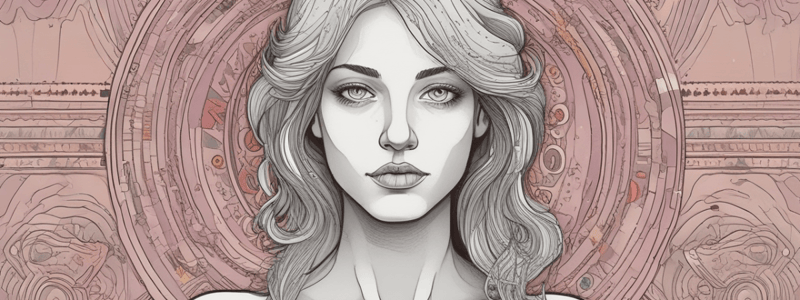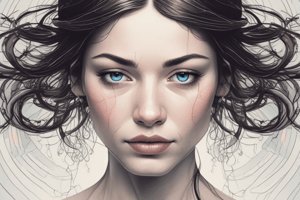Podcast
Questions and Answers
US media tends to show mostly Caucasian or light-skinned models.
US media tends to show mostly Caucasian or light-skinned models.
True (A)
People of different racial and ethnic backgrounds have similar physical features.
People of different racial and ethnic backgrounds have similar physical features.
False (B)
A strong ethnic or racial identity can protect against negative impacts of non-diverse media ideals.
A strong ethnic or racial identity can protect against negative impacts of non-diverse media ideals.
True (A)
Different groups in society have the same values and preferences for ideal body type.
Different groups in society have the same values and preferences for ideal body type.
Research suggests that African-Americans are more likely to view a very thin female body as ideal compared to Caucasians.
Research suggests that African-Americans are more likely to view a very thin female body as ideal compared to Caucasians.
Certain athletic activities can negatively impact teens' body image.
Certain athletic activities can negatively impact teens' body image.
Dancers, gymnasts, and ice skaters often face pressure to increase muscle mass.
Dancers, gymnasts, and ice skaters often face pressure to increase muscle mass.
Activities like football, basketball, and swimming emphasize muscle mass or height.
Activities like football, basketball, and swimming emphasize muscle mass or height.
Teens in sports that do not emphasize particular body types may feel better about their bodies.
Teens in sports that do not emphasize particular body types may feel better about their bodies.
Participation in activities without body type emphasis can help teens feel good about their physical capabilities.
Participation in activities without body type emphasis can help teens feel good about their physical capabilities.
Flashcards are hidden until you start studying
Study Notes
Factors That Influence Body Image
- Body image refers to how people perceive and feel about their bodies, and it is influenced by various factors, including social environment, media, and society.
Social Environment
- Family members can either positively or negatively influence a person's body image, potentially leading to pressure to look a certain way.
- Friends can also impact body image, with unhealthy behaviors like extreme dieting or using steroids to achieve a certain appearance.
- Teens may feel pressure to fit in with their peers and conform to certain physical standards.
Unhealthy Changes to Teens' Bodies
- Teen boys may use steroids or other drugs to increase muscle mass, which can have serious side effects, including liver damage, kidney damage, and heart disease.
- More than 200,000 teens undergo plastic surgery each year, with the most common procedure being rhinoplasty, which carries risks like infection and poor wound healing.
- Teens of color may use unhealthy products to bleach their skin, which can cause mercury poisoning, dermatitis, or steroid acne.
Case Study: How Do I Look?
- Tiffany, a teen, felt self-conscious about her height and skin color, but eventually learned to embrace her appearance by following female role models online.
- Kian, another teen, struggled with acne, but his friend Aaron suggested he see a dermatologist to address the issue.
Media and Society
- Social media can exacerbate the pressure from peers, with teens feeling the need to present a perfect image and seeking approval through "likes".
- The media promotes unrealistic beauty standards, associating certain physical traits with attractiveness and happiness.
- Advertisements and media portrayals can lead to negative body image and low self-esteem.
Body Images in the Media
- The media often portrays males as having broad shoulders, muscular arms, a broad chest, and short hair, which can be unrealistic and unhealthy.
- Males are still developing throughout adolescence, and it is essential to address health issues like underweight, overweight, or obesity.
Research in Action: Diversity in the Media and Body Image
- The media lacks diversity, with only 15% of top 100 films featuring an African-American actor in a leading role, and less than half of these films including African-American, Asian, or Hispanic female characters.
- This lack of diversity can lead to negative self-esteem and body image issues, particularly among people of color.
Race and Ethnicity
- The media tends to promote unrealistic beauty standards, favoring light skin, straight hair, and lack of curves, which can negatively impact people of different racial and ethnic backgrounds.
- Strong ethnic or racial identity can help protect people against the negative impact of these ideals.
- Different cultural and community groups have distinct values and preferences regarding ideal body type and appearance.
Athletic Activities
- Certain athletic activities, such as dancing, gymnastics, and ice skating, can emphasize particular body types and features, leading to negative body image and pressure to conform.
- Other athletic activities, like football, basketball, and swimming, may emphasize muscle mass or height, also contributing to pressure and negative body image.
- Teens who participate in athletic activities that do not emphasize particular body types or features may experience less pressure and feel better about their bodies.
Studying That Suits You
Use AI to generate personalized quizzes and flashcards to suit your learning preferences.




